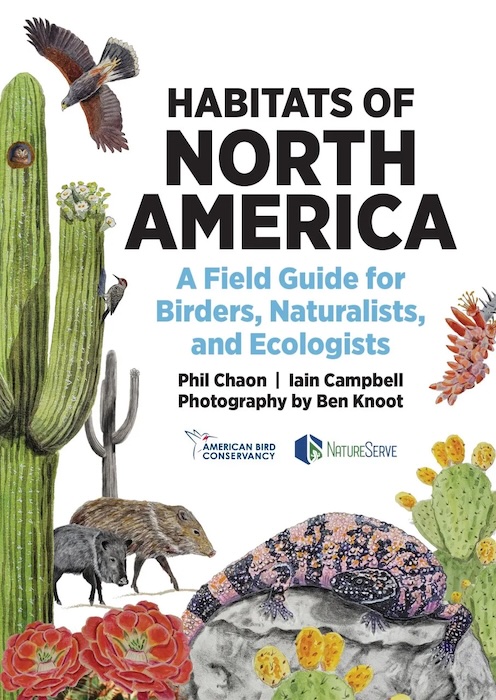| A Field Guide for Birders, Naturalists and Ecologists | Phil Chaon, Iain D Campbell & Bernjamin Jacob Knoot | Princeton University Press | 2025 | Flexibound | 376 pages, colour photos, colour & b/w illustrations, colour distribution maps | ISBN: 9780691245065 |

The Publisher’s View:
Whether you’re a birder, naturalist, outdoor enthusiast, or ecologist, knowing the surrounding habitat is essential to getting the most out of your experiences in the field. This compact, easy-to-use guide provides an unparalleled treatment of the wonderfully diverse habitats of North America. Incisive and up-to-date descriptions cover the unique features of each habitat, from geology and climate to soil and hydrology. Requiring no scientific background, Habitats of North America offers quick and reliable information for anyone who wants a deeper understanding and appreciation of the habitats around them.
- Covers 81 major North American habitats, including wetlands and oceanic habitats
- Features hundreds of colour photos of habitats and their wildlife, a wealth of helpful diagrams and illustrations, and a detailed distribution map for each land habitat
- Concise text provides all the information you need to identify and understand habitats anywhere in North America quickly and accurately
- Discusses iconic and indicator species of birds, mammals, and plants
- Includes an in-depth section on habitat classification – invaluable for ecologists
- Representative habitat accounts describe what you can expect to see and experience there
- Formatted like a field guide for easy reference
The Authors:
Phil Chaon is a professional nature guide and the author (with Iain Campbell, Ken Behrens, and Charley Hesse) of Habitats of the World (Princeton).
Iain Campbell is a professional nature guide and habitat ecologist whose books include (with Ken Behrens and Keith Barnes) Habitats of Africa (Princeton) and multiple bird guides.
Ben Knoot is an award-winning photographer, naturalist, and wildlife tour leader.
Fatbirder View:
You are holidaying in Florida and have snuck away for a bit of birding while your other half is sunning themselves by the hotel pool. You are half an hour away in case your presence is required to apply sun tan cream or fetch another Martini from the poolside bar. Sitting on the tailgate of your hire car you look across the sandy scrub, and the pines beyond. A bird flits on to the limb of a scrub oak with an acorn in their beak, almost obscured from view, its pale blue plumage against the greenery. Thinking you know what you just saw, having poured over the bird guide for the entire flight from home. But you turn to the fieldguide and read the description, finding that the bird you think you saw is more or less confined to, and typical of, sandy scrubland.
It’s just as well you had familiarised yourself with the special habitats of Florida, having consulted Habitats of North America before leaving home. Scrubby oaks – check. Exposed sandy soil – check. Dry open pine woods alongside – check.
Your phone alerts you to a message: Where are you? You hastily text back that you’re are just having a stroll and will see your partner in 30 minutes. On the drive back, you enjoy replaying the image of that Florida Scrub Jay and the charming Burrowing Owls that you had a glimpse of as the phone chime sent them dropping into cover. You plan your next outing, confident that your companion will delight in the scenery and allow you the chance to tick off Bachman’s Sparrows and Brown-headed Nuthatches in the eastern pine savanna they are uniquely suited too.
Do you need any other reason to acquire your copy of the Habitats of North America?
Fatbirder
